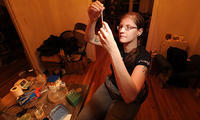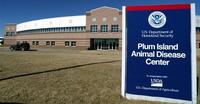-
Garage-lab bugs: spread of bioscience increases bioterrorism risks

There is a new fear about the possible source of a bioterror attack: scientific advances now enable amateur scientists to carry out once-exotic experiments, such as DNA cloning, which could be put to criminal use; as recently as a decade ago, the tools and techniques for such fiddling were confined to a handful of laboratories like those at leading research universities; today, do-it-yourself biology clubs have sprung up where part-timers share tips on how to build high-speed centrifuges, isolate genetic material, and the like
-
-
Texas A&M bioterrorism research may yield rabies cure
Rabies infection is an unusual event in the United States, but it is a problem that kills more than 50,000 people around the world every year; the U.S. Department of Defense is funding research at Texas A&M on counter-measures to bioterrorism — but one of the most immediate outcomes of A&M’s research could be a cure for rabies
-
-
NDM-1 may herald the end of antibiotic era
Researchers warn that the spread of a drug-resistant bacterial gene could herald the end of antibiotics; the bleak prediction follows his research into a drug-resistant bacterial gene called NDM-1, or New Delhi metallo-β-lactamase 1, which was first identified in India; researchers identified 143 cases of NDM-1 across India and Pakistan, but 37 — a surprisingly high figure — in the United Kingdom
-
-
U Rochester lands $15 million to study medical response to nuclear terrorism
Research has revealed that it is not just the immediate effect of radiation that makes adults and children sick; rather, the radiation damage can remain relatively undetected in key tissues and organs, but will trigger life-threatening illnesses after an injury that occurs later; new project places the University of Rochester Medical Center firmly in a leadership position in the counterterrorism effort
-
-
Superbug found in British patients returning from treatment in Asia
An antibiotic-resistant superbug has been found in British patients traveling to Asia for cosmetic surgery, cancer treatment, and transplants and returning to Britain for further care; the bug was found attached to E.coli bacteria, but the enzyme can easily jump from one bacterium to another and experts fear it will start attaching itself to more dangerous diseases causing them to become resistant to antibiotics; in Many Asian countries health standards in many Asian countries are poor and regulations are weak, and antibiotics are available to buy without prescription; this is thought to have encouraged resistance to develop as many infections are exposed to the drugs without being properly killed
-
-
How serious is the threat of an "EMP Pearl Harbor"?
In 1962 the United States conducted a high-altitude nuclear test above Johnston Island, 825 miles southwest of Hawaii; detonated 400 kilometers above the island, the resulting nuclear blast knocked out street lights across Hawaii and tripped circuit breakers, triggered burglar alarms, and damaged a telecommunications relay facility on the island of Kauai; could terrorist, or a nuclear-armed rogue state, launch an EMP Pearl harbor against the United States?
-
-
New college program on food security
The United States has avoided a major terrorist attack to its food chain, but a small vial of a lethal chemical, such as the nerve toxin ricin, could be introduced anywhere along the chain, injuring thousands directly and, like 9/11, affecting whole industries; Polk State College’s newest program, the Agriculture Business/Technology Institute, will address critical industry issues, including the need for greater security in the food chain
-
-
FDA's food-safety monitoring in need of overhaul
A new study of the U.S. food safety regime finds gaping holes in the system; the study finds that shifting to a risk-based food safety system, utilizing a research infrastructure and integrated federal, state, and local government food safety program, can go a long way towards achieving the safer food supply we all desire
-
-
Cholera spreads in flood-ravaged Pakistan
With stagnant water throughout Pakistan, water-borne diseases such as gastroenteritis, malaria, and typhoid, now threaten the nation; there are reports of diarrhoea and cholera among the hundreds of thousands left homeless, and food and drinking water are in short supply
-
-
Plum Island bio lab an inviting target for terrorists

The bio lab on 840-acre Plum Island, a mile-and-a-half off Long Island’s Orient Point, is a Biosafety level 4 facility — the only type of research lab authorized to handle diseases that are communicable between humans and animals and for which there is no known cure; from a boat, terrorists armed with shoulder-fired rockets would have a clear shot, or a plane could dive into the laboratory, dispersing deadly germs into an area from Massachusetts to New York; DHS has decided to build a new lab in Kansas to replace the aging Plum Island center, but some local politicians object, citing the local jobs that would be lost
-
-
3,000 chemical-filled barrels washed into major northeast China river
Severe floods in China’s Jilin Province carried about 3,000 barrels containing toxic chemicals into the Songhuajiang River in Jilin City; in addition, 4,000 empty barrels containing chemical residues were also washed into the river — a major source of drinking water and fishing; each chemical-filled barrel contains about 170 kilograms of chemicals
-
-
Radiation concerns dog full-body scanners
By the end of 2014, TSA will install between 1,950 and 2,200 full-body scanners at checkpoints in all 450 commercial airports in the United States; TSA buys scanners which use two technologies — backscatter X-ray and millimeter wave; since backscatter technology raises persistent worries about radiation, some want to know why TSA should not buy only millimeter-wave scanners
-
-
HHS seeks comments on bioterror select agents list
The biennial review required by the Public Health Security and Bioterrorism Preparedness and Response Act of 2002 is under way; comments about biological agents or toxins that should be added or removed are due by 20 August
-
-
Scientists: Oil spill's "grim reshuffle" of Gulf food web may destroy region's fishing industry
The initial impact of the BP disaster on the maritime food chain in the Gulf are already apparent; scientists warn that if such impacts continue, they will result in a grim reshuffling of sea life that could over time cascade through the ecosystem and imperil the region’s multibillion-dollar fishing industry
-
-
Bioterrorism experts criticize cuts in BioShield to pay for teacher retention
In order to find funds which would prevent teacher layoffs, House Democrats craft an appropriations bill which takes $2 billion from a bioterrorism emergency program; security experts criticize what they call a lack of foresight
-
More headlines
The long view
Are We Ready for a ‘DeepSeek for Bioweapons’?
Anthropic’s Claude 4 is a warning sign: AI that can help build bioweapons is coming, and could be widely available soon. Steven Adler writes that we need to be prepared for the consequences: “like a freely downloadable ‘DeepSeek for bioweapons,’ available across the internet, loadable to the computer of any amateur scientist who wishes to cause mass harm. With Anthropic’s Claude Opus 4 having finally triggered this level of safety risk, the clock is now ticking.”
A Brief History of Federal Funding for Basic Science
Biomedical science in the United States is at a crossroads. For 75 years, the federal government has partnered with academic institutions, fueling discoveries that have transformed medicine and saved lives. Recent moves by the Trump administration — including funding cuts and proposed changes to how research support is allocated — now threaten this legacy.
Vaccine Integrity Project Says New FDA Rules on COVID-19 Vaccines Show Lack of Consensus, Clarity
Sidestepping both the FDA’s own Vaccines and Related Biological Products Advisory Committee and the CDC’s Advisory Committee on Immunization Practices (ACIP), two Trump-appointed FDA leaders penned an opinion piece in the New England Journal of Medicine to announce new, more restrictive, COVID-19 vaccine recommendations. Critics say that not seeking broad input into the new policy, which would help FDA to understand its implications, feasibility, and the potential for unintended consequences, amounts to policy by proclamation.
